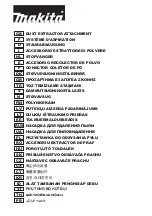
45
Figure 9-3
A collimated telescope
should appear
symmetrical with the
central obstruction
centered in the star's
diffraction pattern.
To accomplish this, you need to tighten the secondary collimation screw(s) that move the star across the field toward the
direction of the skewed light. These screws are located on the secondary mirror holder (see figure 9-1). To access the collimation
screws you will need remove the collimation screw cover to expose the three collimation screws underneath. To remove the
cover place the tip of flat screwdriver underneath the cover and twist until the cover lifts off. Make only small 1/6 to 1/8
adjustments to the collimation screws and re-center the star by moving the scope before making any improvements or before
making further adjustments.
To make collimation a simple procedure, follow these easy steps:
1.
While looking through a medium to high power eyepiece, de-focus a bright star until a ring pattern with a dark shadow
appears (see figure 9-2). Center the de-focused star and notice in which direction the central shadow is skewed.
2.
Place your finger along the edge of the front cell of the telescope (be careful not to touch the corrector plate), pointing
towards the collimation screws. The shadow of your finger should be visible when looking into the eyepiece. Rotate
your finger around the tube edge until its shadow is seen closest to the narrowest portion of the rings (i.e. the same
direction in which the central shadow is skewed).
3.
Locate the collimation screw closest to where your finger is positioned. This will be the collimation screw you will
need to adjust first. (If your finger is positioned exactly between two of the collimation screws, then you will need to
adjust the screw opposite where your finger is located).
4.
Use the hand control buttons to move the de-focused star image to the edge of the field of view, in the same direction
that the central obstruction of the star image is skewed.
5.
While looking through the eyepiece, use an Allen wrench to turn the collimation screw you located in step 2 and 3.
Usually a tenth of a turn is enough to notice a change in collimation. If the star image moves out of the field of view in
the direction that the central shadow is skewed, than you are turning the
collimation screw the wrong way. Turn the screw in the opposite direction, so that
the star image is moving towards the center of the field of view.
6.
If while turning you notice that the screws get very loose, then simply tighten the
other two screws by the same amount. Conversely, if the collimation screw gets
too tight, then loosen the other two screws by the same amount.
7.
Once the star image is in the center of the field of view, check to see if the rings are
concentric. If the central obstruction is still skewed in the same direction, then
continue turning the screw(s) in the same direction. If you find that the ring pattern
is skewed in a different direction, than simply repeat steps 2 through 6 as described
above for the new direction.
Perfect collimation will yield a star image very symmetrical just inside and outside of focus.
In addition, perfect collimation delivers the optimal optical performance specifications that
your telescope is built to achieve.
If seeing (i.e., air steadiness) is turbulent, collimation is difficult to judge. Wait until a better night if it is turbulent or aim to a
steadier part of the sky. A steadier part of the sky is judged by steady versus twinkling stars.
Figure 9-2 -- Even though the star pattern appears the same on both sides of focus, they are asymmetric. The
dark obstruction is skewed off to the left side of the diffraction pattern indicating poor collimation.
Summary of Contents for CPC 1100
Page 1: ...I IN NS ST TR RU UC CT TI IO ON N M MA AN NU UA AL L...
Page 58: ...58 APPENDIX E MAPS OF TIME ZONES...
Page 59: ...59...
Page 60: ...60...
Page 61: ...61...
Page 62: ...62...
Page 63: ...63...
Page 64: ...64...
Page 65: ...65...
















































